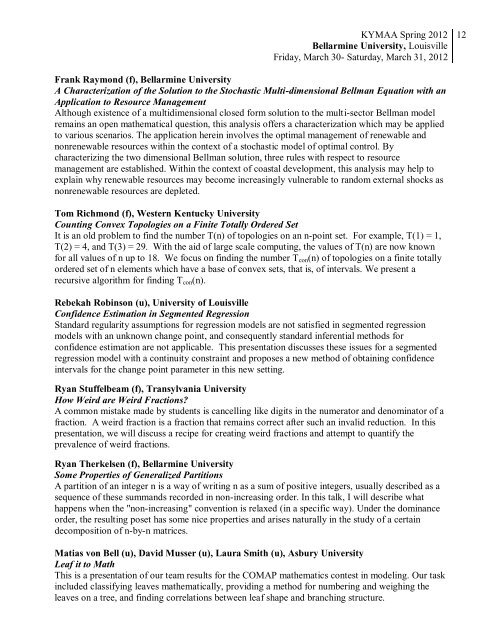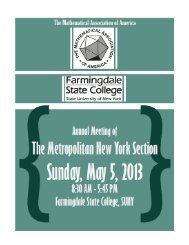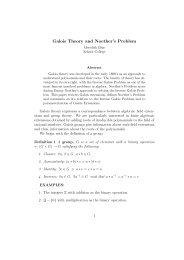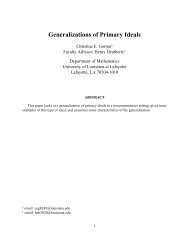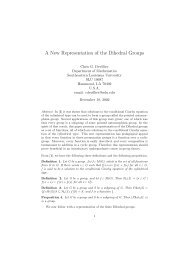Abstracts and Biographical Information - Sections - Mathematical ...
Abstracts and Biographical Information - Sections - Mathematical ...
Abstracts and Biographical Information - Sections - Mathematical ...
Create successful ePaper yourself
Turn your PDF publications into a flip-book with our unique Google optimized e-Paper software.
KYMAA Spring 2012<br />
Bellarmine University, Louisville<br />
Friday, March 30- Saturday, March 31, 2012<br />
Frank Raymond (f), Bellarmine University<br />
A Characterization of the Solution to the Stochastic Multi-dimensional Bellman Equation with an<br />
Application to Resource Management<br />
Although existence of a multidimensional closed form solution to the multi-sector Bellman model<br />
remains an open mathematical question, this analysis offers a characterization which may be applied<br />
to various scenarios. The application herein involves the optimal management of renewable <strong>and</strong><br />
nonrenewable resources within the context of a stochastic model of optimal control. By<br />
characterizing the two dimensional Bellman solution, three rules with respect to resource<br />
management are established. Within the context of coastal development, this analysis may help to<br />
explain why renewable resources may become increasingly vulnerable to r<strong>and</strong>om external shocks as<br />
nonrenewable resources are depleted.<br />
Tom Richmond (f), Western Kentucky University<br />
Counting Convex Topologies on a Finite Totally Ordered Set<br />
It is an old problem to find the number T(n) of topologies on an n-point set. For example, T(1) = 1,<br />
T(2) = 4, <strong>and</strong> T(3) = 29. With the aid of large scale computing, the values of T(n) are now known<br />
for all values of n up to 18. We focus on finding the number Tcon(n) of topologies on a finite totally<br />
ordered set of n elements which have a base of convex sets, that is, of intervals. We present a<br />
recursive algorithm for finding Tcon(n).<br />
Rebekah Robinson (u), University of Louisville<br />
Confidence Estimation in Segmented Regression<br />
St<strong>and</strong>ard regularity assumptions for regression models are not satisfied in segmented regression<br />
models with an unknown change point, <strong>and</strong> consequently st<strong>and</strong>ard inferential methods for<br />
confidence estimation are not applicable. This presentation discusses these issues for a segmented<br />
regression model with a continuity constraint <strong>and</strong> proposes a new method of obtaining confidence<br />
intervals for the change point parameter in this new setting.<br />
Ryan Stuffelbeam (f), Transylvania University<br />
How Weird are Weird Fractions?<br />
A common mistake made by students is cancelling like digits in the numerator <strong>and</strong> denominator of a<br />
fraction. A weird fraction is a fraction that remains correct after such an invalid reduction. In this<br />
presentation, we will discuss a recipe for creating weird fractions <strong>and</strong> attempt to quantify the<br />
prevalence of weird fractions.<br />
Ryan Therkelsen (f), Bellarmine University<br />
Some Properties of Generalized Partitions<br />
A partition of an integer n is a way of writing n as a sum of positive integers, usually described as a<br />
sequence of these summ<strong>and</strong>s recorded in non-increasing order. In this talk, I will describe what<br />
happens when the "non-increasing" convention is relaxed (in a specific way). Under the dominance<br />
order, the resulting poset has some nice properties <strong>and</strong> arises naturally in the study of a certain<br />
decomposition of n-by-n matrices.<br />
Matias von Bell (u), David Musser (u), Laura Smith (u), Asbury University<br />
Leaf it to Math<br />
This is a presentation of our team results for the COMAP mathematics contest in modeling. Our task<br />
included classifying leaves mathematically, providing a method for numbering <strong>and</strong> weighing the<br />
leaves on a tree, <strong>and</strong> finding correlations between leaf shape <strong>and</strong> branching structure.<br />
12


